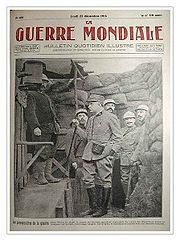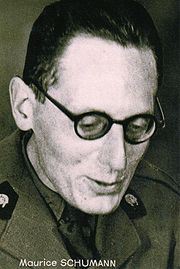.gif)
Military interpreter (France)
Encyclopedia

French Army
The French Army, officially the Armée de Terre , is the land-based and largest component of the French Armed Forces.As of 2010, the army employs 123,100 regulars, 18,350 part-time reservists and 7,700 Legionnaires. All soldiers are professionals, following the suspension of conscription, voted in...
translate into and out of foreign languages for the French military. A sous-officier or interpreter officer
Interpreter officer
An interpreter officer is a commissioned officer of an armed force, who interprets and/or translates to facilitate military operation. Interpreter officers are used extensively in multinational operations in which two countries that do not share a common language are undertaking a joint operation,...
serves in uniform, accompanying the French armed forces on all its foreign expeditions for 200 years. Today known as Officiers et Sous-officiers de Réserve Qualifiés Langues Etrangères (OSRQLE), they were formerly known as Officiers Linguistes de Réserve de l'Armée de Terre (OLRAT), Interprètes/Officiers Interprètes de Réserve de l'Armée de Terre (IRAT/OIRAT) or Officiers de Liaison et Interprète de Réserve (OLIR).
The unit was first set up for Bonaparte's Egyptian expedition, and so their insignia is a sphinx
Sphinx
A sphinx is a mythical creature with a lion's body and a human head or a cat head.The sphinx, in Greek tradition, has the haunches of a lion, the wings of a great bird, and the face of a woman. She is mythicised as treacherous and merciless...
on a blue terrestrial globe divided up by lingual barriers, on a round grey circular background with rays symbolising each of the languages spoken by their unit
French invasion of Egypt
The 1931 "notice sur les Officiers Interprètes" by the unit's commander Abribat (a notice largely inspired by the 1876 "Les Interprètes de l’Armée d’ Afrique" by Laurent-Charles Feraud) began:Conquerors have always been surrounded by interpreters, a necessity to keep their operations moving, but it took Bonaparte to formalise the military interpreter's role and function.
Armée d’Angleterre

1870-1918

Second World War

Training
All military interpreter applicants are usually qualified enough for conducting interpretation right after being commissioned. But, there are several different courses they have to take before being attached to their positions. The courses vary a lot depending on countries, branches, positions and others. (Clooney Kim)Associations


